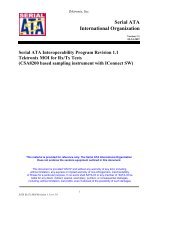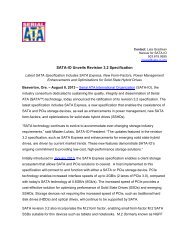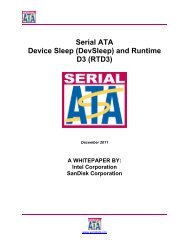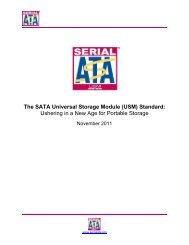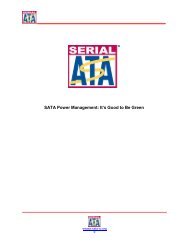1.0 - SATA-IO
1.0 - SATA-IO
1.0 - SATA-IO
Create successful ePaper yourself
Turn your PDF publications into a flip-book with our unique Google optimized e-Paper software.
Test Title: OOB-02: UI During OOB Signaling<br />
Test Title: OOB-03: COMINIT/COMRESET and COMWAKE Transmit Burst Length<br />
Purpose: Measure the UI during OOB Signaling and verify that the Product Under Test, PUT, return<br />
COMINIT/COMRESET and COMWAKE with correct transmit burst length during OOB Signaling specification of<br />
section 7.2.2.7.2, 7.2.2.7.3 and 7.4.21 of Serial ATA revision 2.6.<br />
Last Modification: October 30, 2008<br />
Discussion: This test requirement is only tested at the maximum data rates 1.5 Gb/s and 3.0 Gb/s for PUTs claiming<br />
to be capable of running. The BERTScope transmits the COMRESET/COMINT sequence of 6<br />
COMRESET/COMINIT 160 UI bursts with 480 UI gaps followed by a 45,000 UI gap and captures the 2 ms<br />
response for analysis according to sections 7.4.11 and 7.4.21 of the Serial ATA revision 2.6.<br />
The COMINIT/COMRESET and COMVAKE transmit burst length are measured at +100 mV and -100 mV offsets.<br />
There are four different patterns allowed for OOB signaling; namely Align with positive or negative disparity and<br />
D24.3 with positive or negative disparity.<br />
Resource requirements and setup for OOB are shown in Appendix E.<br />
Test Procedure:<br />
1. On BERTScope select “View” then “Generator” set the “Synthesizer” to 1.5 GHz and click on the<br />
“Clock Output” icon to enable these at full rate (divide by 1),<br />
2. Click on “Pattern”, deselect “Track Detector Pattern” and click on “User Pattern” to select user pattern.<br />
Then click on “Pattern” and “Load User Pattern” to select the OOB-01_COMRESET pattern from the<br />
<strong>SATA</strong> library.<br />
3. Connect the PUT to the <strong>SATA</strong> receptacle<br />
4. Enable the Data Output + (unlink and disable the Data Output – port) at V low equal 0 V and V high equal<br />
2 V which will provide approximately 300 mV at the PUT.<br />
5. On the BERTScope, select “View” then “Detector”. Click on “Error Detector”, click on “Pattern<br />
(User)” and select and select the “All_Zeros” pattern. . Click “Yes” to perform delay line calibrations<br />
if prompted by a pop-up window.<br />
6. Select the “Eye Diagram” view. Click on “Configure” and choose “Cursors” Select the “Single<br />
Cursor” and set it at 100 mV in the center of the eye. Stop the Eye Diagram from running. Click on<br />
“Configure” and “Cursors” again and choose the cursor to be the “Sampling Point”<br />
7. Switch to “View” “Error Location Analysis” and select “BER” Set the “Burst Error Free Threshold to<br />
32. Then proceed to run “Burst Error Length” view. Stop the run when the resulting histogram shows<br />
the distribution of at least 10 (minimum 5 COMINIT/COMRESET and 5 COMVAKE) OOB-03 burst<br />
lengths relative to the 666.666 ps Unit Interval (UI) at the nominal 1.5 Gb/s rate.<br />
Serial ATA Logo Group 30 MOI Revision 1.3 Version <strong>1.0</strong> using BERTScope




